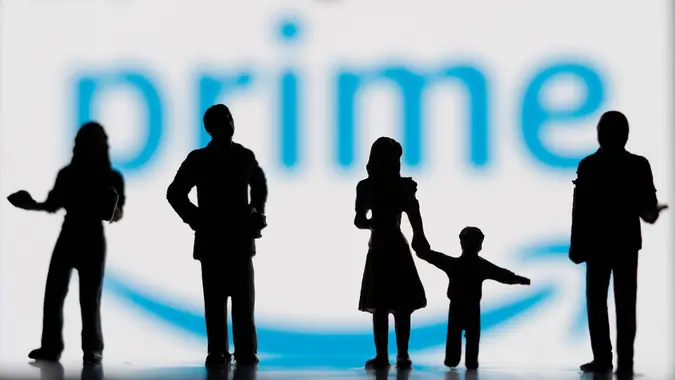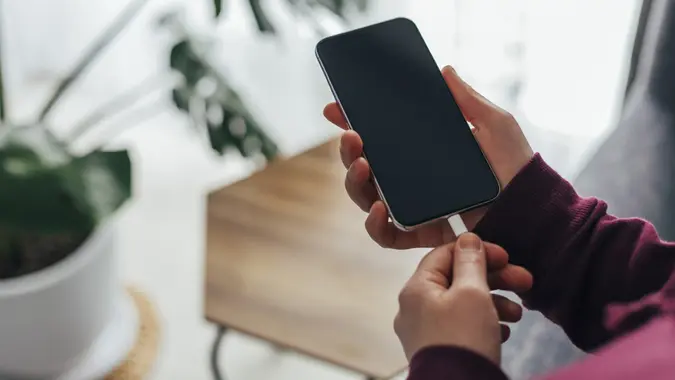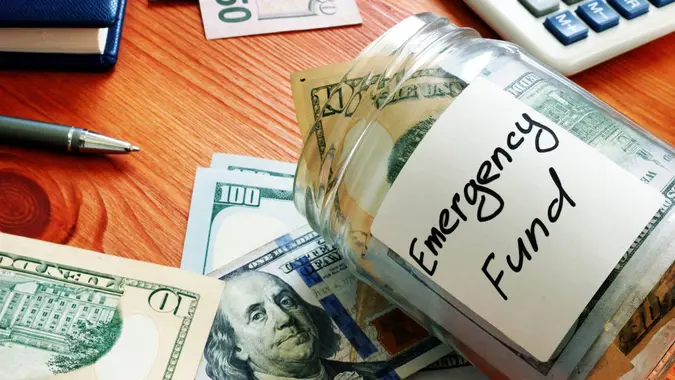Dave Ramsey: How To Embrace a ‘No-Spend’ Challenge for Maximum Financial Growth

Commitment to Our Readers
GOBankingRates' editorial team is committed to bringing you unbiased reviews and information. We use data-driven methodologies to evaluate financial products and services - our reviews and ratings are not influenced by advertisers. You can read more about our editorial guidelines and our products and services review methodology.

20 Years
Helping You Live Richer

Reviewed
by Experts

Trusted by
Millions of Readers
In this crazy up-and-down economy, you might be thinking of ways to save money, spend less and be more intentional with your hard-earned money. One great way to do all of these things is to embrace Dave Ramsey’s no-spend challenge, which is explained on one of Ramsey’s blog posts.
You can keep more of your money, meet big goals faster and even be kinder to the earth.
What Is No-Spend?
The no-spend challenge encourages you to stop spending any money on items you don’t need. You stop impulse buying, stop buying disposable items that need to be replaced quickly and stop wasting your money unnecessarily.
The key is to set a time limit on this challenge so you can track your progress and celebrate your successes.
Of course, you’ll still pay for your essentials — housing, food, transportation and utilities. But everything else gets put on hold.
But wait.
Why would anyone do this?
The Benefits of No-Spend
There are so many great reasons to start a no-spend challenge, many of them obvious.
Save Money
This is the biggie. If you stop spending money on non-essential purchases, you’ll save money. That’s just math.
Get Realistic About Your Spending
The less money you spend and the more you save, the more you’ll see what kind of spending practices you’ve been engaging in. It can be an eye-opening experience.
Be More Intentional
The longer you do the challenge — a month, a year — the more intentional you will become about your spending. You’ll think before you slide that card and you’ll feel better about your purchases as a result.
Be Less Emotional
You’ll also start to see how emotional your spending can be. If you are someone who loves retail therapy, this challenge is a great way to confront those spending habits.
Make Use of Your Existing Items
The no-spend challenge also encourages you to fix things instead of replacing them. Fix the stove, the fridge, the car or whatever other big ticket item you’re considering tossing for a newer version. It is an American tradition to buy things that last and then fix them for as long as possible.
Save the Planet
You also get the “feel goods” of being more eco-friendly when you buy fewer items, especially those “fast-fashion” items that are only intended to last a short while and then end up in a landfill.
Reach Your Goals Faster
Finally, you get to reach your financial goals faster when you spend less. Saving to buy a house? A car? Take a big trip? You’ll get there faster when you hold onto more of your money.
How To Embrace the No-Spend Idea
Now, let’s talk about how to actually embrace the no-spend challenge. Because if you don’t set rules and benchmarks, you’ll be more likely to fall into your old habits. Below are some ways to “lean into” the challenge.
Set a Goal and a Time Limit
First, set a goal, even if it’s just $10,000 extra saved in a year. Or put $50 a week into savings. Whatever your goal is, write it down and give it a time limit. That way, you know what you’re working toward.
Choose Your Time
Don’t take this challenge at Christmas time, around your kids’ birthdays or right before luxury vacation. Set yourself up for success and start the challenge at a time when you know you’ll be less tempted.
Make a List of Needs Versus Wants
Sit down on lined paper and write down what you need to spend. What do you need every month? Write it down. Everything else goes in a “wants” column. Look at this list any time you want to spend money unnecessarily.
If you need it, buy it. If it’s a want, wait.
Buy What You Need
Yes, part of this challenge is to buy what you need. So take care of the essentials and ensure you and your family are taken care of.
Buy in Bulk
It’s a great idea to do all or most of your spending at the beginning of the month so you’re not tempted into a buying pattern. Buy in bulk from big box stores like Costco and get as much as you’ll need for the month. Pay your mortgage and your other bills and fill your tank up with gas.
Then, for the rest of the month, buy only what you need — like fresh produce or a new gas tank.
Plan Meals
Fast food and eating out can be a drain on your bank account. But it can also feel necessary when you’re running late, you’re out and about and you and your kids need to eat. To avoid this seeming emergency, plan your meals and time ahead of time. That way, you’re prepared and you can skip the drive-thru.
Avoid Impulse Buys
The biggest part of the no-spend challenge is to avoid buying anything you don’t need or anything on impulse.
Don’t do it. And then celebrate your win.
Be Flexible in Emergencies
Of course, you want to be flexible in case of emergencies. If you have a medical emergency or a car repair that has to be taken care of, spend the money you need to. This is not an impulse.
Find Free Things to Do
Get creative with this challenge. Find free museum days, go to parks, wander down beaches, pack picnic lunches and find free concerts. There are tons of free things to do. Take advantage of them.
Track Your No-Spending
Be sure to track your progress as you go so you can see how successful you are along the way. It will give you the push you need to keep it up.
Tell All Your Friends
Finally, tell all your friends. The more you share, the more excitement you generate, the more proud of yourself you’ll be and the more willing you’ll be to keep going.
More From GOBankingRates
 Written by
Written by  Edited by
Edited by 

























